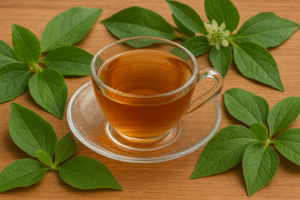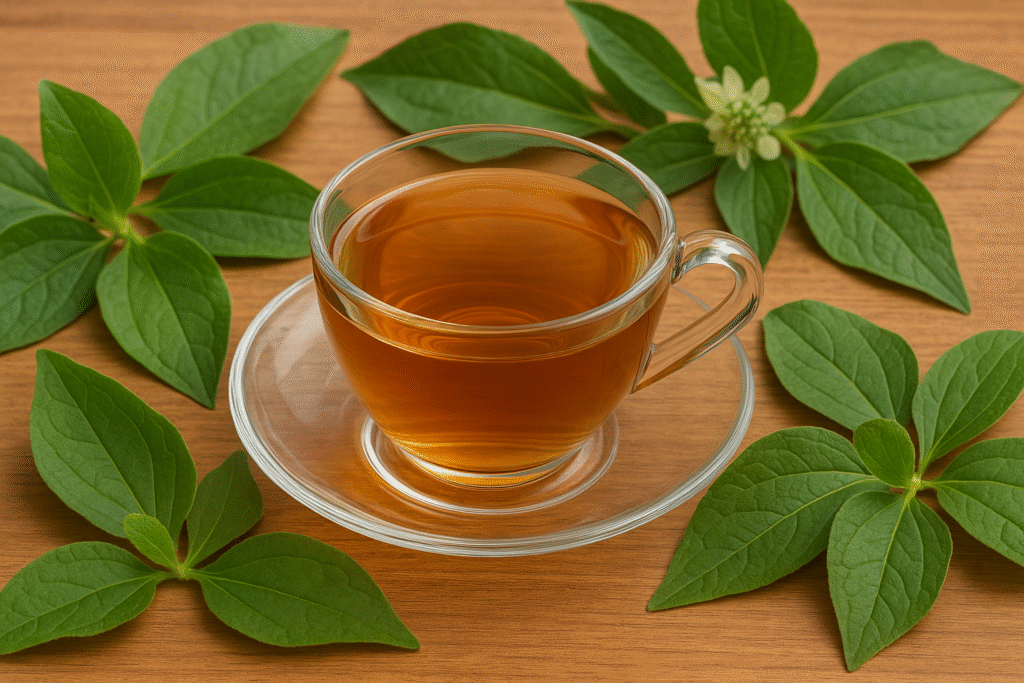Chapéu-de-couro (Echinodorus grandiflorus) is a traditional Brazilian medicinal plant found along riverbanks and wetlands. In folk medicine it’s prized for its anti-inflammatory, diuretic, and antioxidant actions. While many English readers recognize it by its scientific name, you can confidently use chapéu-de-couro and Echinodorus grandiflorus throughout your article to reach both popular and technical audiences.
Below you’ll find five common health concerns that chapéu-de-couro tea may help with, how to prepare it properly, and important safety tips. This guide is informational and does not replace medical advice.
1) Joint Inflammation and Discomfort (Arthritis, Gout, Rheumatism)
The best-known benefit of chapéu-de-couro is relief in joint inflammation. Its bioactive compounds (including flavonoids and tannins) are associated with anti-inflammatory effects, which many users report as a gentle reduction in stiffness and swelling. People dealing with gout also value chapéu-de-couro tea because its diuretic effect supports uric-acid elimination, a key goal in gout management.
How to use:
Drink 2–3 cups/day of chapéu-de-couro tea during flare-ups, then reduce to 1 cup/day for maintenance. Pair with movement (light stretching or short walks) to enhance joint mobility.
Quick tip: Combine with an anti-inflammatory diet (leafy greens, olive oil, fish) for a more comprehensive approach.
2) Fluid Retention, Kidney Support, and Urinary Tract Comfort
Because chapéu-de-couro acts as a natural diuretic, it’s often used when the body is retaining excess fluid—think puffy ankles, mild bloating, or that “heavy” feeling. By gently increasing urine output, the plant helps the body flush water and dissolved wastes. Many people also use chapéu-de-couro tea alongside medical care for kidney stones or urinary tract discomfort, seeking additional hydration and urinary flow.
How to use:
Sip 1 cup of tea after breakfast and 1 cup in the afternoon for a few days. Increase water intake overall to support kidney function.
Important: Persistent pain, fever, or blood in the urine requires immediate medical attention; the tea is a complement, not a cure.
3) Blood Pressure Support (as an Adjunct)
Mild blood-pressure support is another traditional indication for chapéu-de-couro. In folk use, the plant’s diuretic effect helps the body excrete excess sodium and water, which can indirectly support healthier blood-pressure levels. Its antioxidant profile may also contribute to vascular protection.
How to use:
If you already take antihypertensive medication, consult your doctor before adding chapéu-de-couro tea. If approved, start with 1 cup/day and monitor your readings.
Lifestyle pairings: Prioritize potassium-rich foods (bananas, beans), manage stress, and keep regular sleep—these factors work synergistically with chapéu-de-couro.
4) Liver Well-Being and Digestive Comfort
In Brazilian herbalism, chapéu-de-couro is considered hepatoprotective—supportive of liver health. Users seek it when they feel sluggish digestion, occasional fullness after fatty meals, or when they want to support natural detox pathways. By promoting bile flow and providing antioxidants, chapéu-de-couro tea may help the body process fats and neutralize free radicals.
How to use:
Enjoy 1 cup before lunch or early afternoon for a few weeks. Combine with a lighter, fiber-rich diet and reduced alcohol intake to give the liver a break.
Note: If you have a diagnosed liver condition, always work with a healthcare professional; chapéu-de-couro is supportive, not a stand-alone therapy.
5) Skin Calm and Topical Care (Dermatitis, Minor Irritations)
Topically, chapéu-de-couro is used for redness, minor rashes, and oily or acne-prone skin. Thanks to anti-inflammatory and astringent properties, cooled tea can be applied as compresses or toners, helping to soothe irritation and support a clearer look.
How to use (external):
-
Prepare the tea (see below), let it cool completely.
-
Soak a clean gauze or cotton pad and apply to the area for 10–15 minutes.
-
Use once daily for a few days; discontinue if irritation occurs.
How to Prepare Chapéu-de-Couro Tea (Traditional Method)
-
Measure: 1 tablespoon of dried chapéu-de-couro leaves (or 2 tablespoons if fresh) per 500 ml of water.
-
Simmer: Bring water to a gentle boil, add the leaves, and simmer 5 minutes.
-
Steep: Turn off the heat, cover, and let steep 10 minutes.
-
Strain & serve: Drink warm or at room temperature. Optionally add lemon or a small amount of honey.
Serving plan (general): 1–3 cups/day, depending on your goal and tolerance. Always take breaks (e.g., 5 days on, 2 days off) for long-term use.
Safety, Interactions, and Who Should Avoid It
-
Medication interactions: Because chapéu-de-couro is diuretic, it can enhance the effect of diuretic drugs or influence blood-pressure medications. Consult your clinician if you use these.
-
Hydration & minerals: Increased urination may lead to dehydration or mineral loss. Drink water and consider mineral-rich foods.
-
Pregnancy & breastfeeding: Avoid use unless specifically cleared by a professional.
-
Pre-existing conditions: Kidney or liver diagnoses require medical supervision; chapéu-de-couro should be adjunctive only.
-
Allergies/skin tests: For topical use, do a patch test first.
Bottom Line
Chapéu-de-couro (Echinodorus grandiflorus) is a versatile Brazilian herb that may help with joint inflammation, fluid retention, blood-pressure support, liver well-being, and topical skin calming. When used correctly—preferably with professional guidance—it can be a practical, natural ally. Pair chapéu-de-couro tea with hydration, a balanced diet, movement, and adequate sleep to maximize results.

✨ Hydration & Care for Your Hands
Keep your hands soft and protected with
AHAVA Dead Sea Water Mineral Hand Cream.
A fast-absorbing moisturizer enriched with the exclusive Osmoter™ blend,
witch hazel for smoothing, and allantoin for soothing relief.
Perfect for dry, cracked hands in need of deep nourishment.

🌳 Learn More About Native Trees
Did you know that some native species combine ecological value with
economic potential?
Discover how the Marupá tree grows fast and plays an important role
in sustainable development and forest preservation.

